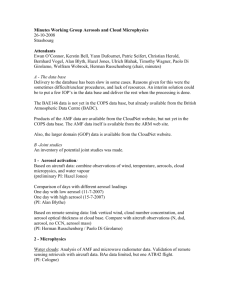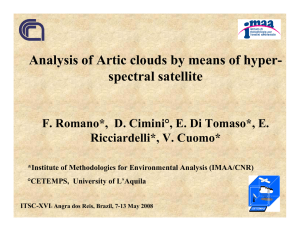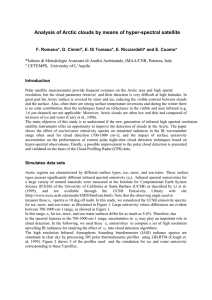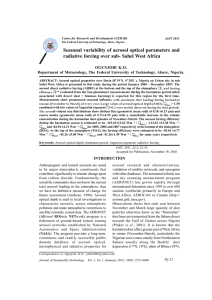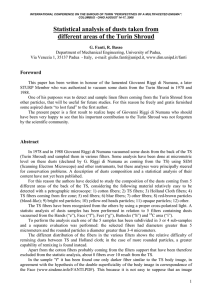Document 12730590
advertisement
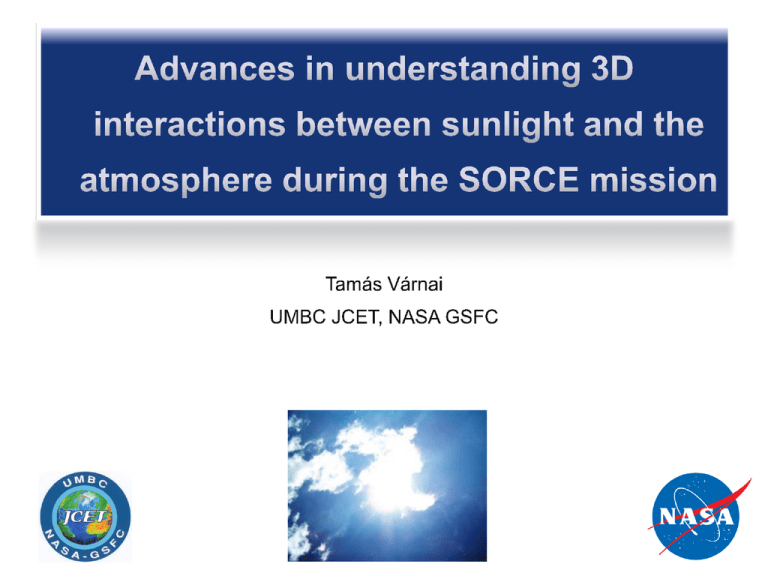
3D world 1D approximation: Ñ= ¶ ¶ ¶ ¶ + + » ¶x ¶y ¶z ¶x 1D approximation Estimate the impacts of 1D approximation Mitigate the impacts (3D corrections or fully 3D calculations) Develop remote sensing methods that gain new information from 3D radiative processes Channeling (Cannon 1970) Improvements in 3D simulations: Speed, polarization Intercomparison of 3D Radiation Codes (Online 3D calculator, public code, reference results, book) Modest immediate impact on development of deep convective clouds (O’Hirok, Frame, Cole) Cloud water and ice Solar heating All clouds in a monthlong global 4 km-resolution simulation Radar measurements of cloud water content at DOE sites Distance (km) Multiyear full-day (24 hour) average difference between 2D and 1D calculations of reflected sunlight -0.3 W/m2 Cole and Barker (2005) -1.2 W/m2 -4.1 W/m2 Várnai (2010) How frequently the observed view-angle dependence of reflected sunlight matches 1D calculations? How big are the brightness-differences between neighboring pixels? Di Girolamo, Liang, Platnick (2010) Seethala and Horváth (2010) Shadowed Illuminated Zhang et al. (2012) 0.55 µm reflectance Global yearlong dataset R3D – R1D Várnai et al. (2013) Two sample scenes out of 1000 from dynamical simulations Neural net reduces errors of 1D retrievals by half or even two-thirds by using multiple views and texture Frank Evans Wen et al. (2005) THOR THOR Cahalan et al. (2005) Pounder et al. (2011) Evans et al. (2006) EarthCARE (launch around 2016) • Our understanding 3D interactions between sunlight and the atmosphere advanced on many fronts during the SORCE mission. • Various approaches have been pursued to mitigate the impacts of 3D processes in remote sensing, and even to take advantage 3D radiative processes in lidar probing of thick clouds. • The EarthCARE mission will be the first to use 3D radiation calculations operationally. Global annual average for warm non-precipitating overcast clouds 3D 1D Top of 1D cloud Heterogeneous Seethala and Horváth (2010) Homogeneous Backscatter1064 nm Color ratio = Backscatter532 nm Scattering cloud large aerosol small aerosol air molecules Wavelength Fraction of cloud-free vertical profiles global night data over ocean July 8 – Aug 7, 2007 Far from clouds (> 5km) Fraction of cloud-free vertical profiles global night data over ocean July 8 – Aug 7, 2007 Close to clouds (< 5km) Fraction of cloud-free vertical profiles global night data over ocean July 8 – Aug 7, 2007 Contributions to MODIS R – R20 km X Distance to nearest cloud [km] All oceans, Aqua along CALIOP track, 11/06-10/07 X X Longitude (°) (0.55 µm - 0.86 µm) Angstrom exponent Latitude (°) AOT0.47 µm Original Corrected Orbit RGB image Cloud product X Cloud optical thickness Dust Sulfate aerosol 2 3 1 4 Black carbon GOCART data 11/06-10/07 Particulate organic matter particles particles Rclose - R far Rel. enh. = particles R far Rparticles obtained by removing: • Rayleigh scattering • Surface reflection for MODIS • Ozone absorption for CALIOP 2 3 1 4 1 2 3 Region CALIOP & Aqua along CALIOP track, 11/06-10/07 4 Rcorr = RMODIS - DR Orbit t - m a cTm (t m , W0 ) DR = [tm,diff (t m , W) - e m0 ] 1- a c Rm,diff (t m , W) CERES can help get ac (narrow band flux reflected by clouds): • Broadband radiance + angular model broadband flux • Convert to narrowband flux by assuming that F F NB obs BB obs » F NB model BB Fmodel R (log scale) Close to clouds: large particles and bluing? Far from clouds: small particles 0.47 0.55 0.65 Wavelength (µm) (log-scale) • Aerosol remote sensing near clouds is challenging • Excluding areas near-cloud risks biases in aerosol data NE Atlantic Ocean, MODIS Terra 2000-2007, September 14-29 Reflectance increase may come from: •Aerosol changes (e.g., swelling in humid air) •Undetected cloud particles •Instrument imperfections •3D radiative effects Várnai and Marshak (2009)
